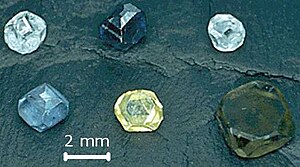Synthetic diamonds, created through advanced technological processes that mimic natural diamond formation, are rapidly gaining popularity and disrupting the market. These lab-grown gems offer ethical and sustainable alternatives to traditional mining practices while maintaining comparable quality and affordability.
As synthetic diamonds continue to evolve, they have the potential to reshape the diamond industry and redefine our perception of this timeless gemstone.
Growing Popularity and Demand for Synthetic Diamonds
As technology continues to advance, synthetic diamonds are experiencing a surge in popularity and demand. There are several factors contributing to this upward trend. One significant reason behind the increasing appeal of synthetic diamonds is their ethical nature.
Unlike natural diamonds, which often raise concerns about mining practices and labor conditions, synthetic diamonds offer a conflict-free alternative. Consumers are becoming more conscious about the origins of their purchases and are drawn to the idea of supporting an industry that does not contribute to environmental harm or human rights issues.
Another aspect that sets synthetic diamonds apart is their versatility in customization. These lab-grown gems can be produced in a wide range of colors and sizes, providing consumers with a greater selection compared to their natural counterparts. This variety allows individuals to find the perfect diamond that matches their preferences and style.
Additionally, the affordability factor plays a significant role in driving the demand for synthetic diamond jewelry. As technology advances and production costs decrease, the price gap between natural and synthetic diamonds is closing.
This makes synthetic diamonds a more accessible option for cost-conscious consumers who still desire the beauty and elegance of diamond jewelry without breaking the bank.
Furthermore, synthetic diamonds offer consistent quality and purity. Unlike natural diamonds that may have imperfections or inconsistencies due to their formation process underground, lab-grown diamonds showcase exceptional clarity and brilliance. This assurance of quality appeals to consumers who value consistency in their purchases.
In summary, the growing popularity and demand for synthetic diamonds can be attributed to various factors such as their ethical appeal, customization options, affordability, and consistent quality.
As consumers become more environmentally conscious while seeking high-quality yet affordable jewelry options, it is no wonder that synthetic diamonds are gaining traction in today’s market.
Exploring the Investment Potential of Synthetic Diamond Stocks
Investing in synthetic diamond stocks presents a promising opportunity in a booming industry. Shifting consumer preferences towards sustainable and ethically sourced products benefit companies in this sector.
Advancements in manufacturing techniques have improved the quality and versatility of lab-grown diamonds, expanding their applications beyond jewelry to industries like cutting tools and semiconductors. Investing in synthetic diamond stocks aligns with sustainable strategies, offering financial gains while supporting ethical practices.
Comparative Advantages Over Natural Diamonds
Investing in synthetic diamond stocks offers distinct advantages over natural diamonds. One key advantage is supply control, as synthetic diamond production can be adjusted based on demand, providing stability for investors.
Synthetic diamonds also have consistent quality and lack imperfections, making them appealing to industries requiring high-performance materials. Additionally, they eliminate concerns related to unethical mining practices and offer the potential for innovation.
Unlike natural diamonds, synthetic diamond production is not limited by geographic constraints, ensuring global accessibility. Overall, these advantages position synthetic diamonds as a compelling alternative in various industries and markets worldwide.
Overview of Major Companies in Synthetic Diamond Production
The synthetic diamond industry is dominated by key players like Element Six and WD Lab Grown Diamonds. These companies invest heavily in technology and innovation to enhance their production capabilities.
Additionally, smaller players like New Diamond Technology and Pure Grown Diamonds focus on producing lab-grown gems with unique branding strategies or specialized products. All these companies contribute to the growth of synthetic diamonds as a sustainable and desirable choice in the market.
| Company | Key Focus |
|---|---|
| Element Six | Research and technological advancements |
| WD Lab Grown Diamonds | Sustainability and ethical practices |
| New Diamond Technology | Unique branding strategies |
| Pure Grown Diamonds | Specialized high-quality products |
In summary, the synthetic diamond production industry showcases major companies driving innovation while smaller players carve out their niches with unique approaches. Together, they contribute to the growth of lab-grown diamonds as a sustainable alternative in the market.
Analysis of Financial Performance and Market Position
Investors looking to capitalize on synthetic diamond stocks must analyze the financial performance and market position of key players. Element Six benefits from its affiliation with De Beers Group, providing resources for research and development while leveraging brand reputation.
Smaller players like New Diamond Technology focus on technology-driven approaches, capturing niche markets and building a strong customer base. Evaluating financial health, market share, and regulatory changes is essential for investors seeking opportunities in this emerging sector.
Market Trends and Consumer Preferences
The performance of synthetic diamond stocks is influenced by market trends and consumer preferences. Shifting trends in the jewelry industry, like increased demand for sustainable and eco-friendly products, can indicate the growth potential of synthetic diamond stocks.
Consumer preferences for customization options, affordability, and ethical considerations also play a significant role in shaping market demands. By staying ahead of these trends, investors can capitalize on the growing popularity of synthetic diamonds.
Technological Advancements Impacting the Industry
Technological advancements have revolutionized the synthetic diamond industry, improving manufacturing techniques and equipment. This has led to increased efficiency, reduced production costs, and greater accessibility of synthetic diamonds for consumers.
Breakthroughs in diamond synthesis methods and gem cutting technologies have created opportunities for companies to expand their product offerings. Investors should monitor these advancements closely as they can drive future growth and innovation in the industry.
| Technological Advancements Impacting Synthetic Diamond Industry |
|---|
| – Improved manufacturing techniques and equipment |
| – Lower production costs and increased efficiency |
| – Greater accessibility of synthetic diamonds for consumers |
| – Opportunities for companies to expand product offerings |
| – Potential for future growth and innovation |
[lyte id=’MK2bPnr201I’]






